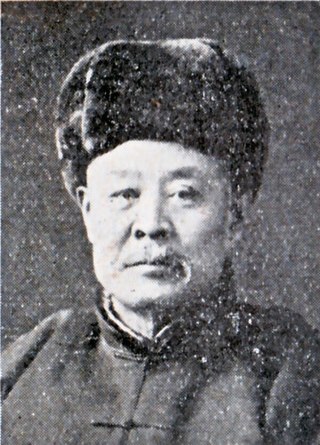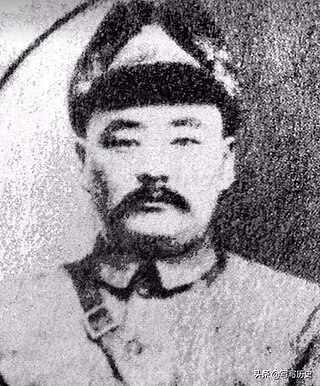
The defense of the Great Wall was a campaign between the armies of Republic of China and Empire of Japan, which took place before the Second Sino-Japanese War officially commenced in 1937 and after the Japanese invasion of Manchuria in 1931. It is known in Japanese as Operation Nekka and in many English sources as the First Battle of Hopei.

The Battle of Rehe was the second part of Operation Nekka, a campaign by which the Empire of Japan successfully captured the Inner Mongolian province of Rehe from the Chinese warlord Zhang Xueliang and annexed it to the new state of Manchukuo. The battle was fought from February 21 to March 1, 1933.
The following is the order of battle of the forces involved in the Battle of Shanghai, during the opening stages of the Second Sino-Japanese War.
The following units and commanders fought in the Defense of the Great Wall of the Second Sino-Japanese War. List as of 20 March 1933.
The order of battle for Operation Chahar, in the history of the Second Sino-Japanese War (1937–1945), was:

The Manchukuo Imperial Army was the ground force of the military of the Manchukuo, a puppet state established by Imperial Japan in Manchuria, a region of northeastern China. The force was primarily used for fighting against Communist and Nationalist guerrillas in Manchukuo but also took part in battle against the Soviet Red Army on several occasions. It initially consisted of former National Revolutionary Army troops of the "Young Marshal" Zhang Xueliang who were recruited after the Japanese invasion of Manchuria en masse, but eventually expanded to include new volunteers and conscripts. The Imperial Army increased in size from about 111,000 troops in 1933 to an estimated strength of between 170,000 and 220,000 soldiers at its peak in 1945, being composed of Han Chinese, Manchus, Mongols, Koreans, Japanese, and White Russians. Throughout its existence the majority of its troops were considered to be mostly unreliable by their Japanese officers and advisers, due to poor training and low morale.

The Empire of Japan's Kwantung Army invaded Manchuria on 18 September 1931, immediately following the Mukden Incident. At the war's end in February 1932, the Japanese established the puppet state of Manchukuo. Their occupation lasted until the success of the Soviet Union and Mongolia with the Manchurian Strategic Offensive Operation in mid-August 1945, towards the end of the Second World War.

The Pacification of Manchukuo was a Japanese counterinsurgency campaign to suppress any armed resistance to the newly established puppet state of Manchukuo from various anti-Japanese volunteer armies in occupied Manchuria and later the Communist Northeast Anti-Japanese United Army. The operations were carried out by the Imperial Japanese Kwantung Army and the collaborationist forces of the Manchukuo government from March 1932 until 1942, and resulted in a Japanese victory.

Tang Juwu, Tang Chu-wu, 唐聚五,(20 April 1898 – 18 May 1939), Chinese officer, general of one of the Anti-Japanese Volunteer Armies resisting the pacification of Manchukuo.

Tang Yulin was a Chinese general who served in the Northeastern Army. An important member of the Fengtian clique that governed Manchuria during the Warlord Era, he served as warlord of Rehe Province. His military incompetence was a major factor Japan's successful invasion of that province in 1934.
The Jilin Self-Defence Army was an anti-Japanese volunteer army formed in 1931 to defend local Chinese residents against the Japanese invasion of northeast China. General Ding Chao, Li Du, Feng Zhanhai, Xing Zhanqing, and Zhao Yi organised the Jilin Self-Defence Army in order to prevent the fall and occupation of Harbin city, Jilin province. This brought all their forces under a unified command. Calling for civilians to form volunteer units and join in the defense of the city, the army reached a strength of 30,000 men in six brigades of Zhang Xueliangs Northeastern army.
The Northeast People's Anti-Japanese Volunteer Army was led by Tang Juwu, formerly the commander of a Northeastern infantry regiment, interned by the Japanese at the beginning of the invasion of Manchuria. It was created by the Northeast National Salvation Society that had appointed Tang as commander following his escape from the Japanese, and helped him link with the local forces which others were organising. Tang also made use of his personal contacts with police chiefs, officials, local gentry militias and the leaders of the Big Swords Society. Tang was able to organize a force which threatened the region to the east of Mukden and communications with Korea.

Zhang Haipeng, was a Chinese Northeastern Army general, who went over to the Japanese during the Invasion of Manchuria and became a general in the Manchukuo Imperial Army of the State of Manchuria.
The Inner Mongolian campaign in the period from 1933 to 1936 were part of the ongoing invasion of northern China by the Empire of Japan prior to the official start of hostilities in the Second Sino-Japanese War. In 1931, the invasion of Manchuria secured the creation of the puppet state of Manchukuo and in 1933, Operation Nekka detached the province of Rehe from the Republic of China. Blocked from further advance south by the Tanggu Truce, the Imperial Japanese Army turned its attention west, towards the Inner Mongolian provinces of Chahar and Suiyuan, with the goal of establishing a northern China buffer state. In order to avoid overt violation of the Truce, the Japanese government used proxy armies in these campaigns while Chinese resistance was at first only provided by Anti-Japanese resistance movement forces in Chahar. The former included in the Inner Mongolian Army, the Manchukuo Imperial Army, and the Grand Han Righteous Army. Chinese government forces were overtly hostile to the anti-Japanese resistance and resisted Japanese aggression only in Suiyuan in 1936.
Liu Guitang was a Chinese bandit and soldier, involved in the Japanese attempt to control Chahar province in 1933. Noted for switching sides several times and returning to banditry. Later, during the Second Sino-Japanese War, he commanded some Nanjing Government puppet troops.
The order of battle Chahar People's Anti-Japanese Allied Army in the Inner Mongolia campaign of 1933.

Wang Ying was a Chinese bandit and minor Japanese puppet warlord from western Suiyuan. He was involved in the Chahar People's Anti-Japanese Army in 1933, commanding a formation called the 1st Route. Following the suppression of the Anti-Japan Allied Army, Wang Ying went over to the Japanese Kwantung Army and persuaded them to let him recruit unemployed Chinese soldiers in Chahar Province. He returned to Japanese-occupied Northern Chahar with enough men to form two Divisions that were trained by Japanese advisors. By 1936 Wang was commander of this Grand Han Righteous Army attached to the Inner Mongolian Army of Teh Wang.
Cui Xingwu, 崔兴五, ; Chinese officer in the army defending Rehe in the Second Sino-Japanese War that defected with his brigade to the Japanese and joined the Army of Manchukuo.
The Suiyuan campaign was a Japanese attempt to increase the size of their puppet state of Inner Mongolia in 1936.
Men Bingyue was a general in the Chinese National Revolutionary Army during the Second Sino-Japanese War. As commander of the 7th Cavalry Division he participated in the Suiyuan Campaign in 1936, defeating the Japanese backed Inner Mongolian Army. After the beginning of the Second Sino-Japanese War in 1937 he was made Commander of the 6th Cavalry Army, fighting in the Battle of Taiyuan defending Suiyuan. In 1940 he was made Deputy Commander in Chief of the 17th Army Group. In 1941, he was made Commander of the 7th Cavalry Army. He died in August 1944 in Chongqing.